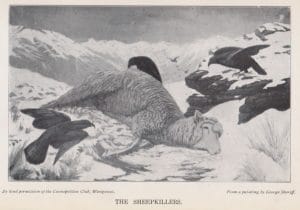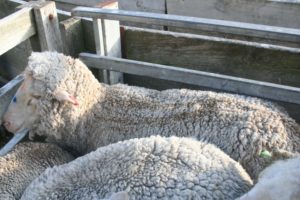Conflict between kea and New Zealand high country sheep is an ongoing issue which prior to protection being granted to kea in the early 1970s resulted in an estimated 150,000 kea killed in a legal bounty system. The bounty was initiated due to kea attacks on sheep resulting in high stock losses (Temple, 2011).
The term ‘kea strike’ or ‘flagging’ was used to describe the physical damage done by a kea to sheep. Kea strike may be more specifically defined as trauma to the back of a sheep caused by a keas beak digging through fleece, hide and flesh in an attempt to locate high energy fat (particularly around the sheep’s kidney area). Sheep may die from direct physical trauma, subsequent blood poisoning (if sheep are unvaccinated), or through physical trauma while trying to escape an attack.
In 2011 and 2012, the Kea Conservation Trust was contacted by the Department of Conservation to help resolve kea strike on sheep on a high country sheep farm. An experimental bird repellent mix, which had shown promise in captive kea trials, was applied to sheep during 2012.

Outcomes
Trialing of the secondary bird repellent anthraquinone (AQ) took place at a high country sheep station in the spring of 2011 (16 Sept – 7 November), winter of 2012 (31 May – 18 July) and winter of 2014 (6 May - 6 June).
2014 Trials
The trial commenced on 6 May 2014 on a flock of mixed-sex rising two-year-old Merino and Perendale sheep. Of the 601 sheep in the trial, 375 sheep were Merino and 226 were Perendale. Of these 140 Merino (37%) and 115 Perendale (51%) were treated and the remaining 346 sheep were untreated (control).
All trial sheep were checked for signs of kea injury before being mustered onto the flats directly below an area where kea strike issues had occurred in previous years. No sheep in the trial had previous signs of kea flagging.
A total of 427 Merino sheep and 256 Perendale sheep were inspected (treated/untreated) for signs of kea strike (flagging or drilling) 6th June (25 days after application). The number of sheep had increased over the trial period as rams had been added to the flocks and some stragglers had been mustered in during the trial period. Essentially these additional sheep have increased the sample of control sheep as they were not marked. Several other flocks of sheep (n = 450) were also mustered into the yards on the 3rd June and no flagging was observed.
No kea flagging was observed on any of the sheep. The repellent was visible on all the treatment sheep and the repellent mix had become hard on the sheep’s wool.
Presence of kea was confirmed during the trial period on only one occasion by the shepherd who heard a kea on 15th May just at dusk.
Results to date are inconclusive and additional trials will need to be conducted to increase sample size and confidence.
2012 Trials
The 2012 trial was conducted on a flock of 337 mixed-sex rising two-year-old merino sheep; 203 of which were treated with the AQ/lanolin mix and the remaining 134 were untreated (control). A total of 341 sheep were mustered up and examined 45 days later. Of these, 197 were treated – 15 of which showed signs of kea strike (7.6%) and 144 were likely untreated – 4 of which had signs of kea strike (2.8%). This amounted to a total of 10.4% sheep showing some evidence of flagging by kea. Review of acoustic recorder data found that kea were present for at least some of this and subsequent periods. The majority of vocalisations occurred in the early hours of the morning (around 2 am).

2011 Monitoring
During spring 2011, a sheep carcass was placed in an area of historical kea strike and monitored by motion sensor camera for evidence of kea interaction. No kea were observed interacting with the carcass and no kea strike events were recorded by the farm during this time. It was considered too late in the season and as such trials of the repellent mix were scheduled for the following winter (2012).